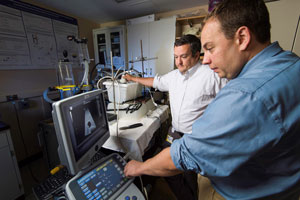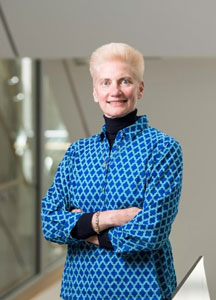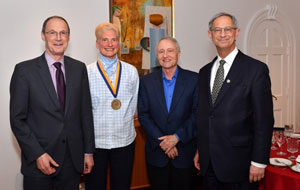Dalecki and Hocking receive UR Technology Development Fund Award
Tuesday, November 15, 2016
Diane Dalecki, Ph.D. (BME) and Denise C. Hocking, Ph.D. (Pharmacology and Physiology) received funding from the UR Technology Development Fund for their project titled “Ultra-collagen for enhanced wound healing”. The project aims to advance an ultrasound-based technology to direct collagen fiber microstructure and enhance the bioactivity of collagen hydrogels. Applications of this technology include fabrication of collagen-based wound dressings that promote healing of chronic wounds.
Emma Grygotis presents at BMES
Thursday, October 6, 2016

Emma Grygotis
Emma Grygotis presented her latest research at the 2016 Meeting of the Biomedical Engineering Society (BMES) held in Minneapolis, MN. Emma presented her poster titled, “Mechanical bioeffects contribute to ultrasound-induced promigratory collagen activity.” Emma is a doctoral candidate in the Department of Pharmacology and Physiology, and a student member of the Rochester Center for Biomedical Ultrasound (RCBU). Emma’s Ph.D. research is mentored by Professor Denise C. Hocking and Professor Diane Dalecki. Emma was also a recent participant in the Young Scholar’s Conference, Mechanisms of Disease Intervention held in Providence, RI.
Carestream, University of Rochester collaborate on new ultrasound technologies
Friday, September 2, 2016

Michael Richards and Doran Mix are
developing a novel ultrasound
technology to characterize the structure
of aortic abdominal aneurisms and
blockages in carotid arteries,
in collaboration with Carestream Health Inc.
(Photo by J. Adam Fenster/
University of Rochester)
Carestream Health, a leader in medical and dental imaging, and an interdisciplinary team of researchers at the University of Rochester will collaborate on developing new technologies to expand the use of ultrasound imaging for medical diagnosis.
Headquartered in Rochester, Carestream entered the ultrasound market earlier this year, and is looking to expand its portfolio of products.
With funding provided by the company and New York State through the Center for Emerging and Innovative Sciences, the collaboration will initially focus on developing ultrasound technologies for:
- Diagnosing tendon damage, led by Stephen McAleavey with Mark Buckley of the Department of Biomedical Engineering. Initially the project will focus on insertional Achilles tendinopathy, a painful heel condition that resists nonsurgical treatments.
- Characterizing the structure of aortic abdominal aneurisms and blockages in carotid arteries, to more accurately assess the risk of ruptures, led by Michael Richards of the Department of Surgery with Marvin Doyley of the Department of Electrical and Computer Engineering.
- Producing handheld devices, using novel system architectures and relatively inexpensive components, led by Zeljko Ignjatovic, with Michael Huang and Doyley, all of the Department of Electrical and Computer Engineering.
“These are three very substantive projects,” said James Burns, CTO of Carestream’s, X-ray and Ultrasound Solutions. “We hope it is the start of a very rich relationship.”
Diane Dalecki, director of the University’s Rochester Center for Biomedical Ultrasound and chair of the Department of Biomedical Engineering, said, “this is a dream match between a company in our own backyard and our researchers, who are eager to take the work they’re doing in the laboratory and translate it to people who are building the products that make a difference for patients and physicians.”
Carestream offers two high-end ultrasound products, Touch Prime and Touch Prime XE, for general ob-gyn, vascular, and abdominal imaging. The company will expand its portfolio to include mid-range and portable devices.
“Through these joint projects, we can innovate in ultrasound technology and applications, and in turn influence Carestream’s technology roadmap. We seek to generate a pipeline of clinically validated ultrasound technologies for new products,” said Ajay Anand, PhD, a Carestream system engineer and principal investigator who worked closely with the University researchers to develop the collaboration. “In addition, we have an opportunity to really enhance the medical ultrasound technology ecosystem in the Rochester area.”
The collaboration is administered by the Center for Emerging and Innovative Sciences, one of 15 Centers for Advanced Technology funded by NYSTAR, a division of the New York State Department of Economic Development. Funding for the first year of the initial two-year phase of the collaboration totals $270,000.
UR Ventures, the University’s technology transfer office, the University’s Center for Business Engagement and its Office of Research and Project Administration, and CEIS worked with Carestream to develop the master research agreement.
Since the early 1960s, University of Rochester researchers have produced pioneering clinical and technological advances in diagnostic ultrasound imaging. The Rochester Center for Biomedical Ultrasound, formed in 1986, includes nearly 100 researchers, including visiting scientists from around the country.
Amanda Smith is Xerox Engineering Research Fellow
Sunday, July 31, 2016
BME undergraduate student, Amanda Smith, was awarded a Xerox Engineering Research Fellowship. Amanda will be performing research as a Xerox Fellow in the laboratory of Professor Diane Dalecki (BME, RCBU). Amanda presented her recent research, titled “Characterization of ultrasound-induced changes in collagen microstructure using high frequency quantitative ultrasound” at the David T. Kearns Center Research Symposium held at the University of Rochester. The Xerox Engineering Research Fellowship Program is a highly competitive program that provides engineering students with research experience. The program begins during the summer preceding the senior year, and continues as an independent research course in the fall and spring semesters of the senior year.
Diane Dalecki appointed new chair of the Department of Biomedical Engineering
Friday, July 1, 2016

Diane Dalecki
Even before Biomedical Engineering became a department, Diane Dalecki wrote the curriculum for what was then a fledgling interdepartmental program for undergraduates.
After the department was formed 15 years ago, she was among its first faculty members.
And on July 1, she became its second chairperson. She replaces Richard Waugh, who, she notes, “hired every one of us, has done a fabulous job growing our department,” and to whom the department is “indebted for its existence.
“I have some very big shoes to fill.”
Waugh has no doubt she will do just that.
“Diane has been an exemplary contributor to the program from the very beginning,” he said. “She was our first director of undergraduate studies. She ran our first accreditation visit. She started BME 101 and turned it into a course that really had teeth and became a model for our EAS 10X courses (offered by departments school-wide). She implemented hands-on labs as part of a freshman class that enrolls more than 100 students, which is no mean feat.”
“She’s always been there, extraordinarily dedicated and devoted to the department, and I think everybody senses that.”
Waugh, 64, will continue to be a BME faculty member, run his research lab and serve as the University’s associate vice president for research. However, he said the time seemed right to step down as department chair for a couple of reasons. His wife, a schoolteacher, is retiring and he would like to have more time for travel.
Moreover, after 19 years as BME program director, then department chair, “I just felt like it was time to give somebody else a turn,” Waugh said. “There are still opportunities for growth, so the new chair would still have a chance to set some directions.”
The department, though relatively new, has had the largest undergraduate enrollment in the Hajim School for several of the past few years. It has led the Hajim School in female enrollment and in numbers of female faculty. The department’s programs for Senior Design and mentoring of junior faculty have served as a model for the rest of the school.
Dalecki sees the department at a transition point. “For a long time we were a new department, then a growing department, and now we are much more stable. That gives us opportunities now to tackle the things that will really make us a robust, top-ranked BME program. That’s where we are headed next.”
The department, established in 2000, is a joint program shared by the Hajim School of Engineering & Applied Sciences and the School of Medicine and Dentistry at the University of Rochester. It consists of 18 primary faculty members with expertise spanning biomechanics, biomaterials, regenerative medicine, neuroengineering, nanotechnology, imaging, and biomedical optics. The department enrolled 368 undergraduates and 70 graduate students during the 2015–16 academic year and led the Hajim School’s female undergraduate enrollment with 48 percent.
Dalecki is excited that the two new members joining the faculty this year – Edmund Lalor from Trinity College in Dublin, Ireland, and Ross Maddox from the University of Washington -- both bring expertise in neuro-engineering, which will strengthen not only the department but its ties with the Medical Center. Close association with a medical center is “a cornerstone of any elite biomedical department,” she noted.
She’s also excited at the opportunity to work with the nearly 1,000 alumni of the department – nearly every one of whom she has taught as freshmen.
“Our students when they are here, are so dedicated to our department,” Dalecki observed. “I want to maintain those ties with them, and keep them interested in our department and engaged with the things we’re doing.”
Eric Comeau and Denise Hocking present at TERMIS
Friday, July 1, 2016
The latest research from the labs of Professors Diane Dalecki and Denise Hocking was presented at the European Chapter Meeting of the Tissue Engineering and Regenerative Medicine International Society held in Uppsala Sweden. Eric Comeau presented a lecture titled "Ultrasound as a tool to direct microvessel network formation and morphology." Eric presented another line of his research in a poster titled "Ultrasound fields to non-invasively pattern microparticles in situ". Eric is a doctoral candidate in BME and his research is co-mentored by Professor Diane Dalecki (BME) and Professor Denise Hocking (Pharmacology and Physiology). Additional work from the Dalecki and Hocking labs was presented by Professor Hocking in the poster titled "Therapeutic effects of ultrasound on dermal wound healing in diabetic mice." Dalecki, Hocking, and Comeau are all members of the Rochester Center for Biomedical Ultrasound (RCBU).
Diane Dalecki named Distinguished Professor of Biomedical Engineering
Tuesday, April 19, 2016

From left to right: Peter Lennie,
Dean of the Faculty of Arts,
Science and Engineering; Diane Dalecki,
Distinguished Professor of
Biomedical Engineering and Director
of the Rochester Center for
Biomedical Ultrasound; Kevin Parker,
William May Professor in Engineering
and inventor of the Blue Noise Mask,
and Joel Seligman, University President & CEO
Medical ultrasound technology uses high-frequency sound waves to produce detailed images that help physicians diagnose conditions affecting the body’s organs and soft tissues. What if this technology could also be used to help treat the problem? Diane Dalecki ’83, ’85 (MS), ’93 (PhD), director of the Rochester Center of Ultrasound, has already asked the question, and she is currently working on the answer.
Dalecki’s lab, which is dedicated to advancing the use of ultrasound in medicine and biology, is developing ultrasound-based technologies for tissue engineering and regenerative medicine. The ultimate goal: have the ability to fabricate living, functional artificial tissues and organs.
Tissue engineering and regenerative medicine are just a part of an impressive list of work that led to Dalecki being named the University’s Distinguished Professor of Biomedical Engineering.
“Diane has become one of the country’s leading experts on the interaction between ultrasound and biological systems,” said Joel Seligman, president, CEO, and G. Robert Witmer, Jr. University Professor. “As she was the first person in the world to pace heartbeats with pulsed ultrasound, it is particularly appropriate that she be the first recipient of this professorship.”
The distinguished professorship was established by the University through royalties from the Blue Noise Mask. Invented by Kevin Parker, Ph.D., the William F. May Professor in Engineering, and Theophano Mitsa ’88 (MS), ’91 (PhD), the Blue Noise Mask is a widely adopted halftoning technique that prints shades of gray in less time and at a higher quality than traditional methods. It is a patented process that has been licensed worldwide by more than a dozen companies, including Hewlett-Packard, one of the world’s largest computer printer manufacturers. The royalties have funded four other endowed distinguished professorships and provided support for research and scholarships.
“Funding made possible by the Blue Noise Mask underscores the importance of recognizing world-class work and retaining world-class people,” said Robert L. Clark, senior vice president for research and dean of the Edmund A. Hajim School of Engineering & Applied Sciences. “Diane is at the top of both categories as an outstanding researcher and an exceptional teacher.”
Dalecki has been a recipient of the Goergen Award for Excellence and Artistry in Undergraduate Education and is a three-time recipient of the Undergraduate Engineering and Applied Sciences Professor of the Year Award.
For information on how to support Diane Dalecki’s work or research being conducted in another area, contact Eric Brandt, (585) 273-5901.